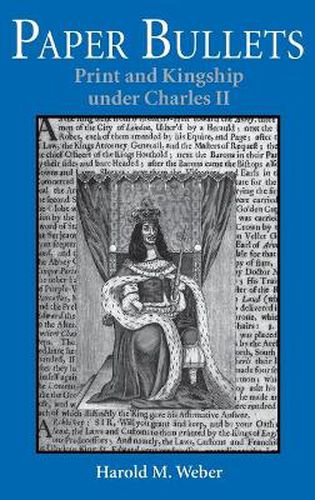Readings Newsletter
Become a Readings Member to make your shopping experience even easier.
Sign in or sign up for free!
You’re not far away from qualifying for FREE standard shipping within Australia
You’ve qualified for FREE standard shipping within Australia
The cart is loading…






The calculated use of media by those in power is a phenomenon dating back at least to the seventeenth century, as Harold Weber demonstrates in this illuminating study of the relation of print culture to kingship under England’s Charles II. Seventeenth-century London witnessed an enormous expansion of the print trade, and with this expansion came a revolutionary change in the relation between political authority – especially the monarchy – and the printed word. Weber argues that Charles’ reign was characterized by a particularly fluid relationship between print and power. The press helped bring about both the deconsecration of divine monarchy and the formation of a new public sphere, but these processes did not result in the progressive decay of royal authority. Charles fashioned his own semiotics of power out of the political transformations that had turned his world upside down. By linking diverse and unusual topics – the escape of Charles from Worcester, the royal ability to heal scrofula, the sexual escapades of the merry monarch, and the trial and execution of Stephen College – Weber reveals the means by which Charles took advantage of a print industry instrumental to the creation of a new dispensation of power, one in which the state dominates the individual through the supplementary relationship between signs and violence. Weber’s study brings into sharp relief the conflicts involving public authority and printed discourse, social hierarchy and print culture, and authorial identity and responsibility – conflicts that helped shape the modern state.
$9.00 standard shipping within Australia
FREE standard shipping within Australia for orders over $100.00
Express & International shipping calculated at checkout
The calculated use of media by those in power is a phenomenon dating back at least to the seventeenth century, as Harold Weber demonstrates in this illuminating study of the relation of print culture to kingship under England’s Charles II. Seventeenth-century London witnessed an enormous expansion of the print trade, and with this expansion came a revolutionary change in the relation between political authority – especially the monarchy – and the printed word. Weber argues that Charles’ reign was characterized by a particularly fluid relationship between print and power. The press helped bring about both the deconsecration of divine monarchy and the formation of a new public sphere, but these processes did not result in the progressive decay of royal authority. Charles fashioned his own semiotics of power out of the political transformations that had turned his world upside down. By linking diverse and unusual topics – the escape of Charles from Worcester, the royal ability to heal scrofula, the sexual escapades of the merry monarch, and the trial and execution of Stephen College – Weber reveals the means by which Charles took advantage of a print industry instrumental to the creation of a new dispensation of power, one in which the state dominates the individual through the supplementary relationship between signs and violence. Weber’s study brings into sharp relief the conflicts involving public authority and printed discourse, social hierarchy and print culture, and authorial identity and responsibility – conflicts that helped shape the modern state.